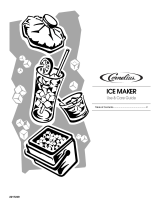
I Ljio# ioi0_,> :I ' ..............
...........;de" _ {_< ? I_,;_<:071 ¢:_II.!]
Pour assurer une bonne a@ation de la machine £ glagons,
I'avant dolt _tre completement degage. Les autres c6tes et le
dessus de I'appareil peuvent _tre dissimules, mais
I'installation dolt permettre de tirer la machine a glagons vers
I'avant pour I'entretien, si necessaire.
Pour installer la machine a glagons, il faut avoir un tuyau
souple d'alimentation en eau froide de 1/4"(6,35 mm) de
diametre exterieur en cuivre avec un robinet et un systeme de
vidange par gravite ou une pompe a condensats pour
pousser I'eau vers un drain existant
Choisir un endroit bien aere ou la temperature est sup@ieure
55°F (13°C) et inf@ieure a 110°F (43°C). Pour tirer le
meilleur rendement de I'appareil, la temperature ambiante
dolt se situer entre 70°F (21°C) et 90°F (32°C).
Cet appareil dolt _tre installe a un endroit protege contre les
elements, comme le vent, la pluie, les embruns ou les
egouttures.
Lorsque I'appareil est installe sous un comptoir, observer les
dimensions d'ouverture indiquees. Placer les composants
electriques et de plomberie dans la zone recommandee sur
I'illustration.
REMARQUE:
• V@ifier que le cordon d'alimentation n'est pas coince
entre la machine a glagons et le placard.
• V@ifier que le conduit de raccordement a la canalisation
d'eau n'est pas coince entre la machine a gla(_ons et le
placard.
• V@ifier que le tuyau d'evacuation (sur certains modeles)
n'est pas coince entre la machine a gla(_ons et le placard.
34"
(86,4 cm)
Min.
341/2 ''
(87,6 cm)
Max,
_1 I-
281/2''
(72,4 cm)
_-'_ 15"
(38,1 cm)
A. Zone recommand_e pour lee composants
_lectriques et de plomberie
B. Niveau du plancher
II est recommande de choisir un emplacement ou le plancher
est de niveau. IIest important que la machine a glagons soit
d'aplomb pour bien fonctionner. Au besoin, il est possible de
regler la hauteur de la machine a glagons en changeant la
position des pieds de nivellement Voir la section
"Nivellement".
},ii 1){?<) 111 d;_ )T}._{; I ;:<:I ']<:I<I{Lf.._
Risque de choc electrique
Brancher sur une prise a 3 alveoles reliee a la terre.
Ne pae enlever la broche de liaison a la terre.
Ne pas utiliser un adaptateur.
Ne pas utiliser un cable de rallonge.
Le non-respect de ces instructions peut causer
un deces, un incendie ou un choc electrique.
Avant de deplacer la machine a gla(_ons a sa place definitive, il
faut s'assurer que le raccordement electrique a ete fait
correctement.
IIfaut un circuit d'alimentation electrique CA seulement de
115 volts, 60 Hz, de 15 ou 20 amperes, mis a la terre
conformement aux instructions du Code national de I'electricite
et des codes et reglements Iocaux.
II est recommande de reserver un circuit special a la machine
glagons. Utiliser une bofte ot] I'alimentation ne peut pas _tre
coupee a I'aide d'un commutateur ou d'un interrupteur a tirage.
IMPORTANT : Si ce produit est connecte a une prise protegee
par un disjoncteur de fuite a la terre, un declenchement
intempestif peut se produire et causer une perte de
refroidissement La qualite des gla(_ons peut en _tre affectee. Si
un declenchement intempestif se produit et si les gla(_ons
semblent de pietre qualite, jeter le tout.
M_thode de mise a la terre recommand_e
Pour votre propre securite, cet appareil dolt _tre mis a la terre.
L'appareil comporte un cordon d'alimentation electrique a trois
broches pour la mise a la terre. Pour minimiser les risques de
choc electrique, le cordon d'alimentation electrique dolt _tre
branche sur une prise de courant murale de configuration
correspondante, a trois alveoles, reliee a la terre conformement
au Code national de I'electricite et aux codes et reglements
Iocaux. S'il n'y a pas de prise de courant correspondante, il
incombe au client de faire installer une prise de courant murale
trois alveoles mise a la terre par un electricien qualifie.
< .-,'1 :; ,., -, ,. iilllli_lOll[i:_<! +_111(!'I {) U
.'_I.)1_I l<4[l{llSd _ ">' " ' _ ....
Une alimentation en eau froide avec une pression entre 30 et
120 Ib/po 2(207 et 827 kPa) est necessaire pour faire fonctionner
la machine a glagons. Si vous avez des questions au sujet de la
pression de votre eau, appeler un plombier qualifie agree.
Alimentation en eau par osmose inverse
IMPORTANT : La pression de I'alimentation en eau entre le
systeme d'osmose inverse et la valve d'arrivee d'eau de la
machine a gla(;ons dolt _tre entre 30 et 120 Ib/po _(207 et
827 kPa).
Si un systeme de purification de I'eau par osmose inverse est
raccorde a votre alimentation en eau froide, la pression de I'eau
au systeme dolt _tre d'un minimum de 40 a 60 Ib/po _(276
414 kPa). Le systeme d'osmose inverse dolt fournir 1 gal. (3,79 L)
d'eau par heure pour un fonctionnement correct de la machine
glagons.
16




















